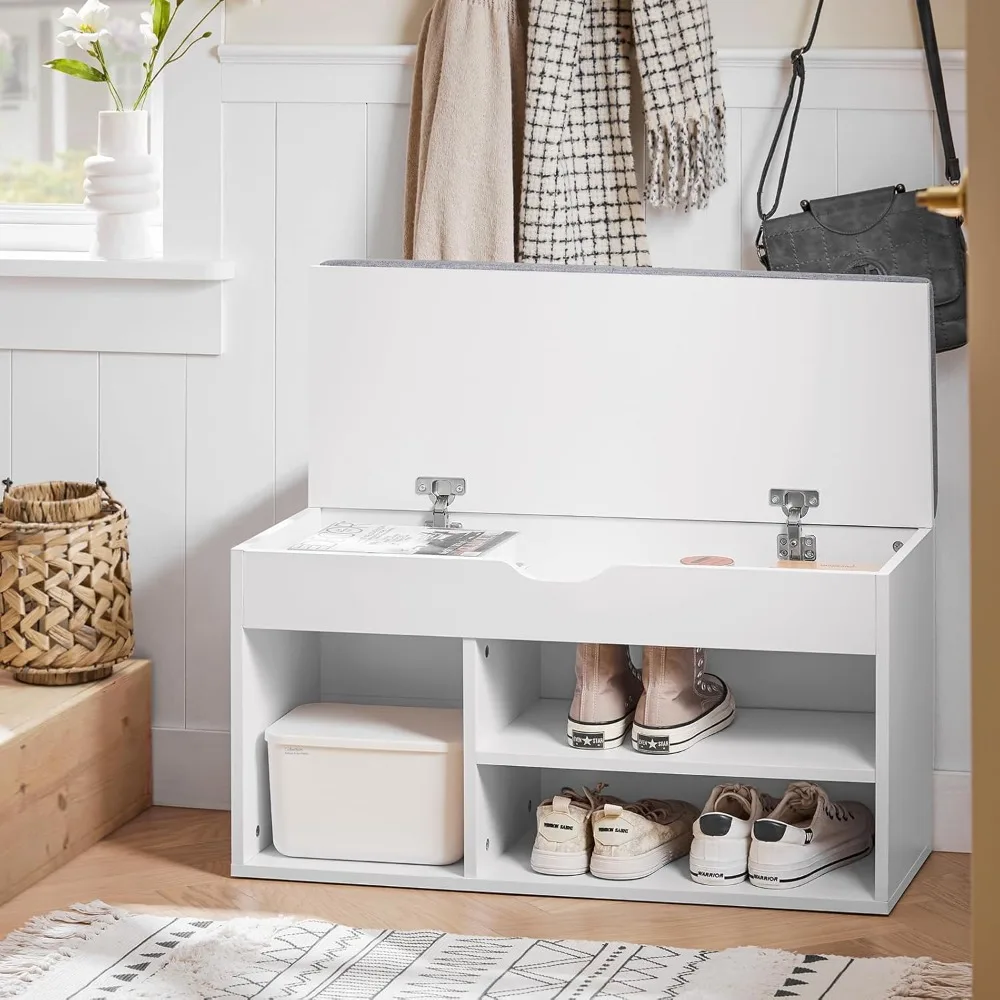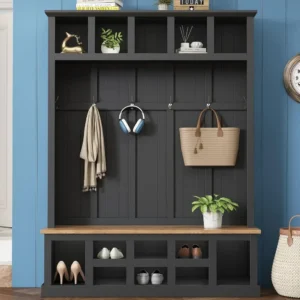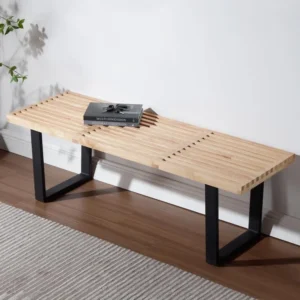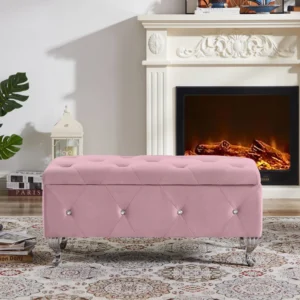Why Your Small Home Desperately Needs a Mudroom Bench
When living in a small home, every square inch matters. The entryway often becomes ground zero for clutter—shoes scattered across the floor, coats draped over whatever surface is available, and keys mysteriously disappearing when you’re already running late. This daily chaos not only creates visual stress but also wastes precious minutes of your day.
A mudroom bench offers a practical solution to this universal small-home problem. Rather than allowing your entryway to become a catch-all dumping ground, a strategically placed bench creates structure in your daily coming-and-going routine.
The benefits of incorporating a mudroom bench in your small space include:
- Space maximization: A well-designed bench uses vertical space and creates dedicated storage where there was once just floor area
- Dedicated “drop zone”: Items have a specific place to land, preventing the spread of clutter throughout your home
- Practical seating: No more hopping on one foot while putting on shoes or struggling to untie laces while standing
- Improved organization: With everything in its place, your mornings become smoother and your evenings more relaxing
Implementing space-saving entryway benches can transform not just your physical space but also your daily quality of life, making them an essential addition to any small home.
Key Considerations When Planning Your Small-Space Mudroom Bench
Before diving into specific solutions, you need to assess your unique space and needs. This thoughtful planning ensures your mudroom bench truly works for your home rather than creating new problems.
Space Assessment
- Measure your available area carefully: width, depth, and height
- Identify your space type: narrow hallway, corner, convertible closet, or open area
- Consider traffic flow—will the bench obstruct movement?
- Note the location of doors, windows, and electrical outlets that might impact placement
Storage Inventory
Create a list of items you need to store regularly:
* How many pairs of shoes per person?
* Seasonal items (umbrellas, winter gear, summer hats)
* Daily essentials (keys, wallets, mail)
* Special considerations (sports equipment, pet supplies)
Budget Framework
- DIY options typically range from $100-300 in materials
- Store-bought benches vary from $150-800 depending on size and features
- Custom solutions generally start at $500 and increase with complexity
Essential Features to Prioritize
- Seating height: 18-20 inches (45-50 cm) for comfortable use
- Minimum depth: 14 inches (35 cm) for sitting without feeling perched
- Weight capacity appropriate for household members
- Durable materials that withstand daily use
When evaluating options, the complete guide to choosing compact benches can help you determine which features are non-negotiable for your specific situation and which you might compromise on to save space.
Clever Mudroom Bench Solutions for Narrow Hallways
Narrow hallways present unique challenges, but with the right approach, even the slimmest spaces can accommodate functional entryway storage.
The key to success in narrow passages is selecting benches with slim profiles—ideally under 12 inches (30 cm) deep. This ensures adequate walking space remains while still providing essential functionality. Look for streamlined designs that sit flush against the wall with minimal protrusion.
Wall-mounted or floating benches create a particularly effective solution for tight hallways. By eliminating legs, these designs create an illusion of more floor space while providing the same seating and storage benefits. The clean lines of floating benches contribute to a less cluttered visual effect, making the entire hallway appear more spacious.
For maximum efficiency, consider bench-and-hook combinations that utilize vertical wall space above the seating area. This approach provides storage for coats and bags without requiring additional floor space, essentially doubling your storage capacity in the same footprint.
Our collection of narrow entryway benches offers specifically designed solutions that balance slim profiles with practical functionality, ensuring your hallway remains navigable while gaining valuable organization.
Maximizing Corners and Nooks with Smart Bench Designs
Corners often represent wasted space in small homes, but they actually offer unique opportunities for mudroom solutions. By thinking beyond traditional straight benches, you can transform these awkward areas into highly functional zones.
L-shaped bench designs follow the contours of your corner, providing more seating and storage than a straight bench would in the same footprint. When measuring for a corner installation, be sure to account for both walls and consider how the bench will interact with any nearby doors or walkways.
For small alcoves and recessed areas, standalone compact benches can transform previously unused spaces into practical mudroom zones. Look for designs that maximize depth rather than width to take full advantage of these nook areas.
Built-in corner solutions offer perhaps the most efficient use of space, as they can be custom-fitted to the exact dimensions of your corner. While these typically require more investment, they utilize every available inch and can incorporate features specific to your needs.
Explore our corner entryway bench options to find specialized solutions that convert these challenging spaces into some of your home’s most functional areas.
Transforming Small Closets into Mini-Mudrooms
If your entryway lacks dedicated mudroom space, an underutilized closet can become an organizational powerhouse with the right transformation approach. This strategy works particularly well in apartments and smaller homes where traditional mudrooms aren’t possible.
Start by removing the closet door to open up the space and make it part of your entryway. This simple change creates an immediate sense of expanded room while maintaining the natural boundaries of the closet area. Consider replacing the door with a curtain if you occasionally want to conceal the contents.
Next, install a bench that fits the closet’s width, creating a dedicated seating area. For closets with standard dimensions, benches 24-36 inches (60-90 cm) wide typically fit well. Ensure the depth allows comfortable seating while leaving enough room to maneuver.
Maximize vertical storage by installing hooks, shelves, or a pegboard system above and around the bench. The existing closet structure often provides good support for these additions without requiring significant construction.
Don’t forget lighting—closet interiors are often dim, making a small battery-operated light or LED strip essential for functionality. This simple addition dramatically increases usability, especially during darker winter months.
Finding the right approach to organize small entryway bench areas within converted closets creates surprising amounts of storage in spaces that were previously underutilized.

Creating a Defined “Mudroom Zone” in Open-Concept Homes
Open-concept homes often lack traditional entry areas, making it essential to create visual and functional boundaries for your mudroom space. The key lies in establishing a distinct zone without disrupting the flow of your open floor plan.
Hall trees serve as excellent all-in-one solutions for open spaces, combining seating, hanging storage, and shelving in a single unit. These freestanding pieces create an instant mudroom without requiring wall attachments, making them perfect for rental properties or homes where permanent installations aren’t desired.
To further define your entry zone visually, consider adding an area rug that complements your bench. A 3×5 foot (approximately 90×150 cm) rug creates sufficient definition without overwhelming the space. Choose durable, easy-to-clean materials like indoor/outdoor rugs that can handle the traffic of an entryway.
In truly multi-purpose areas, look for dual-function furniture like storage benches that blend with living room décor. These pieces can serve as both entryway seating and occasional seating for the main living space, maximizing functionality in limited square footage.
Our entryway hall tree collection features complete solutions that help establish clear entry zones even in the most open floor plans, creating organization where architectural boundaries don’t exist.
Smart Storage Bench Styles for Small Spaces
Different bench styles offer varying benefits for small homes. Understanding these differences helps you select the best option for your specific constraints.
Built-in Benches
These custom-fit solutions maximize every available inch and create a seamless look. While they typically represent a higher investment (starting around $400 for materials plus installation), built-ins offer unmatched space efficiency. They’re ideal for awkward dimensions where standard furniture won’t fit properly.
Freestanding Benches
Offering versatility and mobility, freestanding benches work well for renters or those who might rearrange their space. These come in the widest variety of styles and price points ($150-600) and don’t require installation expertise. The tradeoff is slightly less space efficiency compared to built-ins.
Floating Benches
With their wall-mounted design, floating benches create a modern look while preserving valuable floor space. They make cleaning underneath simple and contribute to a more spacious feel. Installation requires finding wall studs for proper support, and weight capacity may be more limited (typically 250-300 pounds).
Hall Trees with Integrated Benches
These all-in-one solutions combine seating with vertical storage, making them excellent space maximizers. While they have a larger footprint than simple benches, their multifunctionality often justifies the space investment. Prices typically range from $200-700 depending on materials and features.
For detailed examples of each type, our collection of space-saving entry benches offers options specifically scaled for compact living environments.
Under-Bench Storage Solutions That Maximize Every Inch
The space beneath your mudroom bench represents prime real estate for storage in a small home. Different under-bench configurations offer unique benefits worth considering.
Open Cubbies
Simple and accessible, open cubbies provide easy visibility and quick access to items. Each standard-sized cubby (approximately 12×12 inches or 30×30 cm) typically holds 2-3 pairs of adult shoes or can house baskets for smaller items. The open design encourages regular use but keeps items visible, requiring more thoughtful organization.
Drawer Systems
For a cleaner appearance, drawer systems conceal contents while maintaining easy access. Drawers work especially well for items you don’t need daily access to or things you prefer to keep hidden. Consider soft-close mechanisms to prevent slamming in small spaces where noise carries easily.
Lift-Top Designs
Offering maximum storage volume, lift-top benches create a large compartment beneath the entire seating surface. This design excels at storing bulky items like blankets, sports equipment, or seasonal gear. Look for hinges with safety features that prevent accidental closing while in use.
Pull-Out Shoe Trays
Specialized shoe storage that slides out provides superior organization for footwear while maximizing depth. Each tray typically accommodates 4-6 pairs of shoes depending on size and style, making this an efficient solution for homes with limited floor space.
Explore our entryway bench storage options to find under-bench solutions that make the most of your limited square footage with these clever configurations.
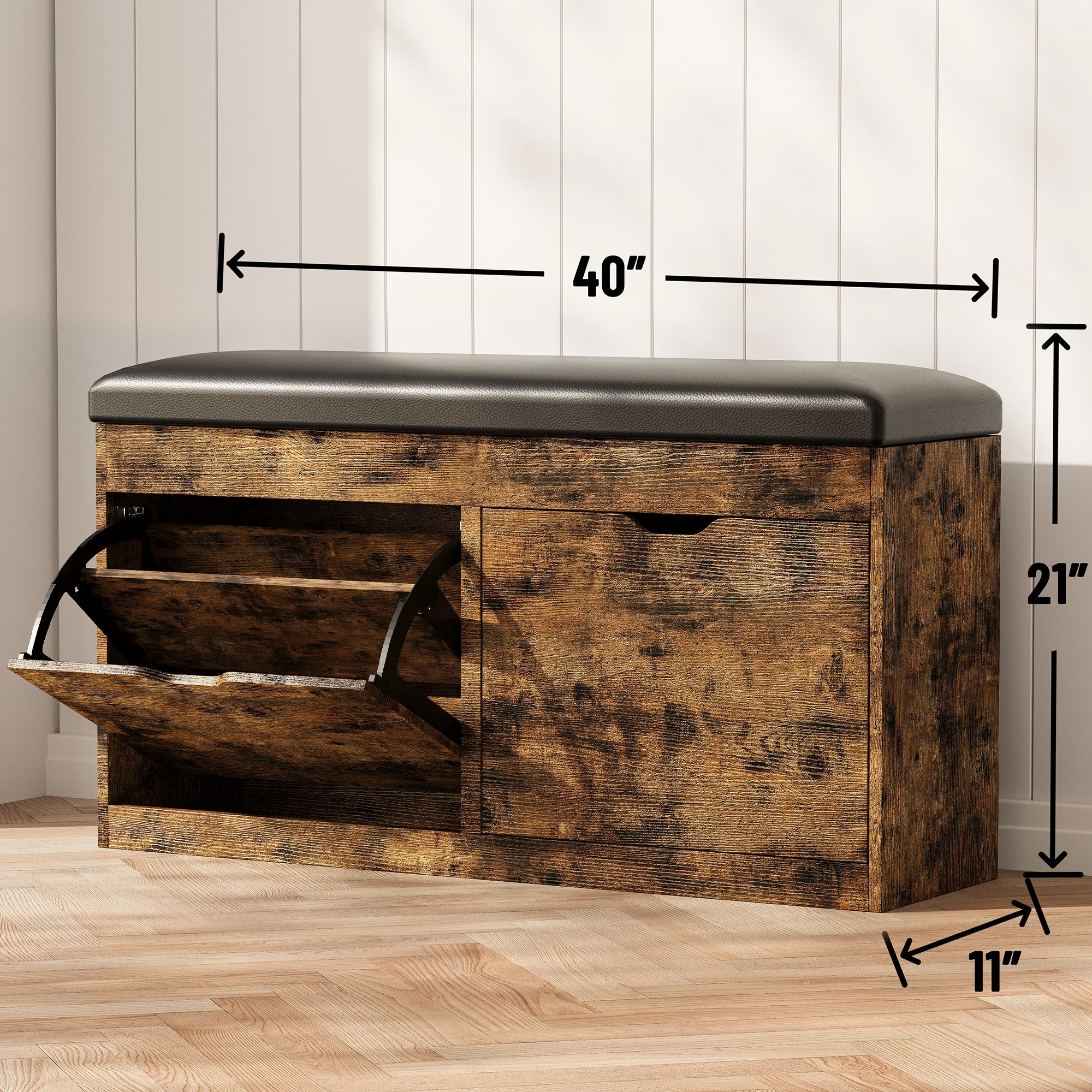
Vertical Storage: Maximizing Wall Space Above Your Bench
When floor space is limited, looking upward unlocks valuable storage potential. The wall area above your mudroom bench can dramatically increase your organization capacity without requiring additional square footage.
Strategic Hook Placement
Install hooks approximately 6 inches (15 cm) apart to prevent overcrowding. Position everyday items at easy-reach heights (about 48-60 inches/120-150 cm from the floor for adults) and seasonal items higher up. Consider installing a second, lower row of hooks (30-40 inches/75-100 cm from floor) for children’s access or shorter items.
Shelving Options
Floating shelves installed 12-18 inches (30-45 cm) above hooks provide additional storage for less frequently used items. Verify weight limits based on your wall construction—drywall with proper anchors typically supports 10-25 pounds per anchor, while direct stud mounting can handle 50+ pounds per stud.
Pegboard Systems
For ultimate flexibility, pegboard installations allow you to reconfigure hooks and small shelves as your needs change. This works particularly well for families with growing children whose storage needs evolve over time.
Cabinet Integration
Upper cabinets installed above benches provide concealed storage for items you don’t want visible. Consider cabinets with glass fronts or open sections to prevent a heavy, closed-in feeling in tight spaces.
Our bench hooks and storage collection features thoughtfully designed vertical solutions that pair perfectly with seating to create complete mudroom systems even in the most compact areas.
Coat Rack Shoe Bench, Corner Entryway Bench, Corner Hall Tree, Shoe Bench for Entryway
$313.58 Select options This product has multiple variants. The options may be chosen on the product pageCorner Entryway Bench, Entryway Bench with Cushion, Modern Entryway Bench, Shoe Bench for Entryway
$476.34 Select options This product has multiple variants. The options may be chosen on the product pageBench with Hooks and Storage, Entryway Hall Tree, Mudroom Bench with Cubbies, Mudroom Bench with Shoe Storage
$818.38 Select options This product has multiple variants. The options may be chosen on the product pageModern Entryway Bench, Wood Entryway Bench, Wood Mudroom Bench
$497.69 Select options This product has multiple variants. The options may be chosen on the product pageEntryway Coat Rack Bench, Entryway Hall Tree, Farmhouse Mudroom Bench, Mudroom Bench with Shoe Storage
$805.09 Select options This product has multiple variants. The options may be chosen on the product pageEntryway Bench with Cushion, Small Entryway Bench
$466.79 Select options This product has multiple variants. The options may be chosen on the product page
Material Selection for Durability and Small-Space Style
The materials you choose for your mudroom bench significantly impact both its longevity and how it affects your small space visually.
Wood Options
Solid wood provides exceptional durability with a 10+ year lifespan under typical use. While it represents a higher investment, its ability to withstand daily wear makes it cost-effective long-term. Engineered wood offers a more budget-friendly alternative with good durability when properly sealed against moisture. For sustainability and character, reclaimed wood brings unique charm while often being surprisingly sturdy.
Metal Frames
Steel and aluminum frames offer outstanding strength-to-weight ratios, making them excellent for floating or minimalist designs. Their slim profiles work particularly well in tight spaces, and many feature powder-coated finishes resistant to rust and scratches. Metal-frame benches with wood seats combine industrial durability with warmth.
Upholstery Considerations
In high-traffic entryways, choose performance fabrics with 30,000+ double rub counts or easy-clean materials like vinyl or leather. Removable cushions offer the best of both worlds—comfort when seated and the ability to clean thoroughly or replace as needed.
Finish Selection
Lighter finishes visually expand small spaces by reflecting more light. Consider white, light gray, or natural wood tones to create an airy feel. For dark finishes, balance with lighter walls or accessories to prevent the space from feeling closed in.
Browse our wood mudroom bench collection to find pieces that combine durability with style-conscious design for small entryways.
Design Styles That Complement Small Home Aesthetics
Your mudroom bench should harmonize with your overall home design while maximizing functionality in limited space. Different styles offer unique advantages for small entryways.
Modern Minimalist
Characterized by clean lines, hidden storage, and floating designs, modern minimalist benches create visual spaciousness. These pieces often feature multi-functional elements and neutral color palettes that blend seamlessly with contemporary interiors. Their streamlined profiles work exceptionally well in the smallest spaces where visual clutter must be minimized.
Farmhouse-Inspired
Combining rustic elements with practical design, farmhouse benches bring warmth to small entryways. Look for shiplap details, distressed finishes, and metal accents that add character without overwhelming the space. These designs often feature substantial open storage that encourages an organized but lived-in aesthetic.
Mid-Century Modern
With their tapered legs and organic shapes, mid-century benches create a sense of openness by allowing light to flow underneath. These designs typically feature warm wood tones and clean silhouettes that work well in small spaces with retro influences. Their moderate scale fits comfortably in apartments and smaller homes.
Coastal and Cottage
Light finishes, beadboard details, and casual comfort define these relaxed styles. Their typically lighter color palettes help small spaces feel airy and bright. Look for practical features like cubbies and hooks integrated into charming, approachable designs.
Exploring modern minimalist benches for small spaces reveals how contemporary design principles can create highly functional entryways with minimal visual weight.
DIY Mudroom Bench Projects Perfect for Small Spaces
Creating your own mudroom bench allows you to customize dimensions perfectly for your unique space while potentially saving money. Here are approachable projects for various skill levels.
Simple Bench with Cubbies
This beginner-friendly project requires basic tools (circular saw, drill, sander) and approximately $100-150 in lumber and supplies. A weekend project for most DIYers, the basic design features a seating surface with divided storage underneath. Pre-cut lumber from home improvement stores can simplify the process if you lack cutting tools.
Repurposed Furniture Transformation
Give new life to secondhand dressers, bookshelves, or entertainment centers by converting them into mudroom benches. Remove drawers to create cubbies, add a cushioned top for seating, and install hooks above for a complete solution. This approach typically costs $50-100 plus your time and creativity.
Cabinet-Based Bench
Kitchen base cabinets make excellent foundations for mudroom benches. A standard 36-inch (90 cm) cabinet provides substantial storage, and adding a wood top creates seating. This approach offers professional-looking results with minimal carpentry skills required. Budget around $150-250 depending on whether you use new or salvaged cabinets.
Whichever approach you choose, careful planning and precise measurements remain critical. Allow for extra time if you’re new to DIY projects, and consider creating a cardboard mock-up before cutting expensive materials.
For step-by-step guidance on creating custom solutions, our resource on DIY mudroom benches for limited spaces provides detailed plans scaled for small homes.
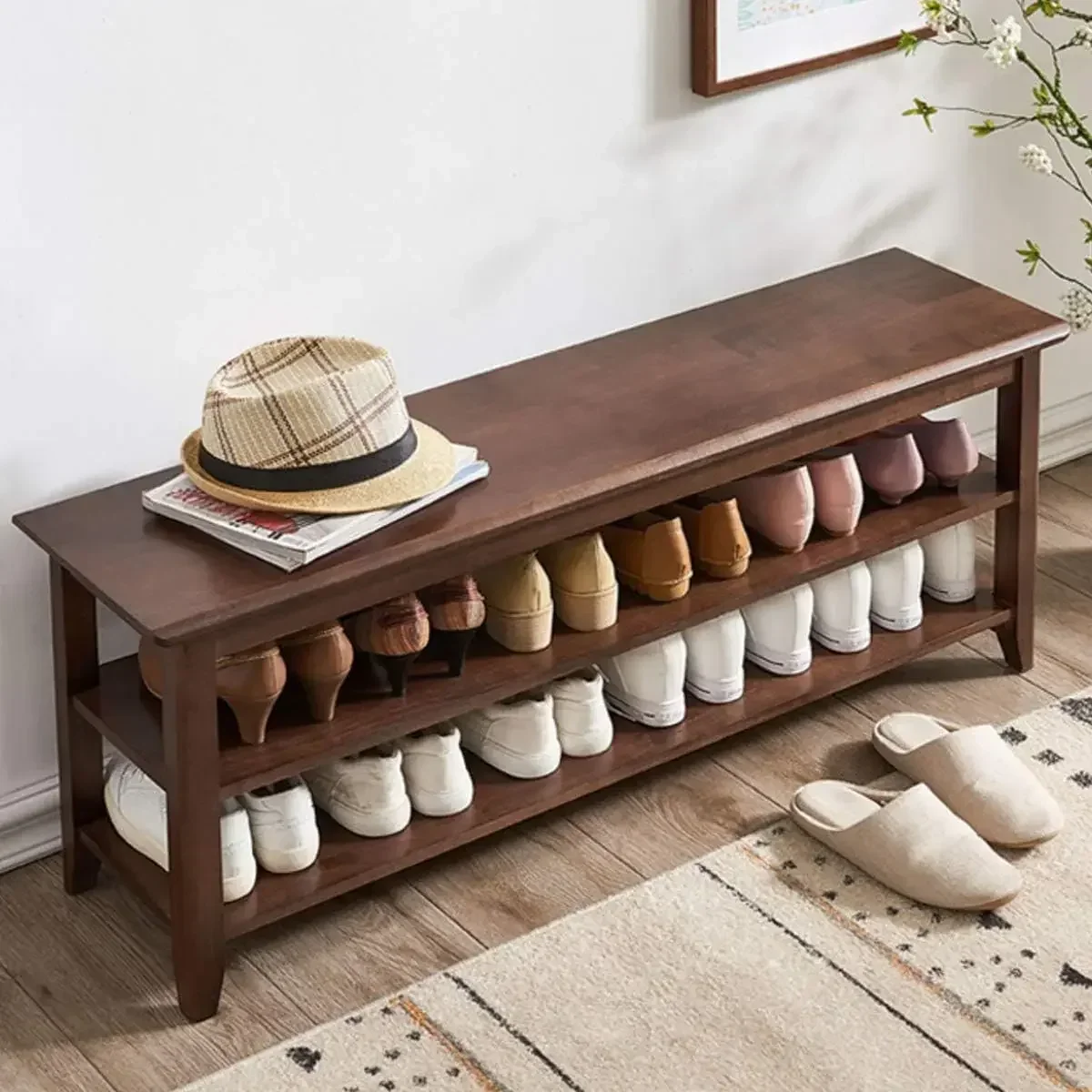
Where to Find Pre-Made Mudroom Benches for Small Homes
If DIY isn’t your preference, plenty of retail options offer well-designed mudroom benches specifically scaled for small spaces.
Furniture retailers specializing in apartment-sized pieces often carry benches under 40 inches (100 cm) wide, perfect for compact entryways. Online marketplaces provide the widest selection, with detailed dimensions allowing you to verify the fit before purchasing.
When shopping for pre-made options, always verify:
* Exact dimensions (width, depth, and height)
* Weight capacity
* Assembly requirements (some furniture requires significant assembly)
* Material quality and durability ratings
Ready-made small entryway benches save time and ensure professional results, particularly important if you have limited tools or DIY experience.
How to Maintain Organization in Your Small Mudroom Area
Even the best-designed mudroom bench requires maintenance systems to remain functional. Implementing simple routines prevents your organized space from reverting to chaos.
- Implement the one-in-one-out rule: When adding a new coat, bag, or pair of shoes, remove another item to prevent overcrowding
- Schedule weekly 10-minute resets: Briefly reorganize, return misplaced items, and wipe down surfaces
- Create seasonal rotation systems: Store off-season items elsewhere to free up premium mudroom space
- Assign specific spots: Give each family member their designated hooks and cubbies to prevent arguments and confusion
- Clean by material type: Wood surfaces need different care than metal or upholstery—follow manufacturer guidelines for longest life
These practical space-saving entryway ideas help maintain organization systems that work with your family’s natural habits rather than against them.
The Impact of Good Lighting on Small Entryway Benches
Proper lighting transforms a functional mudroom area into a welcoming entry point while improving usability. In small spaces, thoughtful lighting becomes even more critical.
Wall sconces mounted beside or above your bench save valuable surface space while providing focused illumination. Look for fixtures that direct light downward to illuminate the bench area without creating harsh glare.
Recessed lighting offers another space-conscious solution, providing overhead illumination without visual intrusion. For rental properties or homes where electrical work isn’t possible, battery-powered puck lights with adhesive mounts create similar effects without wiring.
Consider lighting temperature carefully—warmer bulbs (2700-3000K) create a more inviting atmosphere, while cooler lights (3500-4000K) improve visibility for finding small items. Aim for approximately 75-100 lumens per square foot in entryway areas for adequate brightness.
Motion-activated options provide additional convenience, automatically illuminating your mudroom area when you enter with arms full of groceries or when searching for items in the early morning.
Personalizing Your Small Mudroom Bench
Functional doesn’t have to mean sterile. Adding personality to your mudroom bench creates a welcoming entry that reflects your home’s character without sacrificing organization.
Consider adding a cushion in a durable, washable fabric that complements your color scheme. Beyond comfort, cushions provide an opportunity to introduce pattern and texture that ties your entryway to the rest of your home. Choose 2-3 inch (5-7.5 cm) thick padding for comfort without excessive height.
Incorporate baskets and bins that enhance your aesthetic—natural materials like seagrass and rattan add warmth, while canvas and metal options offer modern simplicity. Label containers for family members or categories to maintain organization while adding a personalized touch.
A strategically placed mirror above your bench serves dual purposes—checking your appearance before leaving and visually expanding the space. Even in the smallest entries, a mirror measuring 18-24 inches (45-60 cm) creates significant impact without overwhelming the area.
For seasonal refreshes, swap out small elements like cushion covers or bin styles rather than larger pieces. This approach allows you to update your space without requiring additional storage for off-season items.
Are Mudroom Benches Worth It for Very Small Apartments?
For extremely limited spaces like studio apartments or micro-units, traditional mudroom benches might seem impractical. However, scaled solutions can still provide significant benefits even in the smallest homes.
Consider the minimum functional threshold—a bench as narrow as 28 inches (70 cm) wide can still provide seating and storage for one person. For the smallest spaces, wall-mounted flip-down options create seating only when needed, folding away when not in use.
Multi-purpose furniture becomes essential in truly tiny spaces. Look for benches that serve as seating for dining or work during the day while providing entryway organization. Corner-optimized designs make use of often-wasted spaces even in the smallest floor plans.
The key question becomes not whether you have room for a mudroom bench, but whether you can afford not to have one. Even in very small apartments, the organization benefits typically outweigh the space investment when properly scaled solutions are implemented.
For the smallest homes, focus on the core functions most important to you—perhaps prioritizing shoe storage and a small seating area while utilizing wall space for coats and bags. This targeted approach ensures you gain the most valuable benefits even with severe space constraints.

